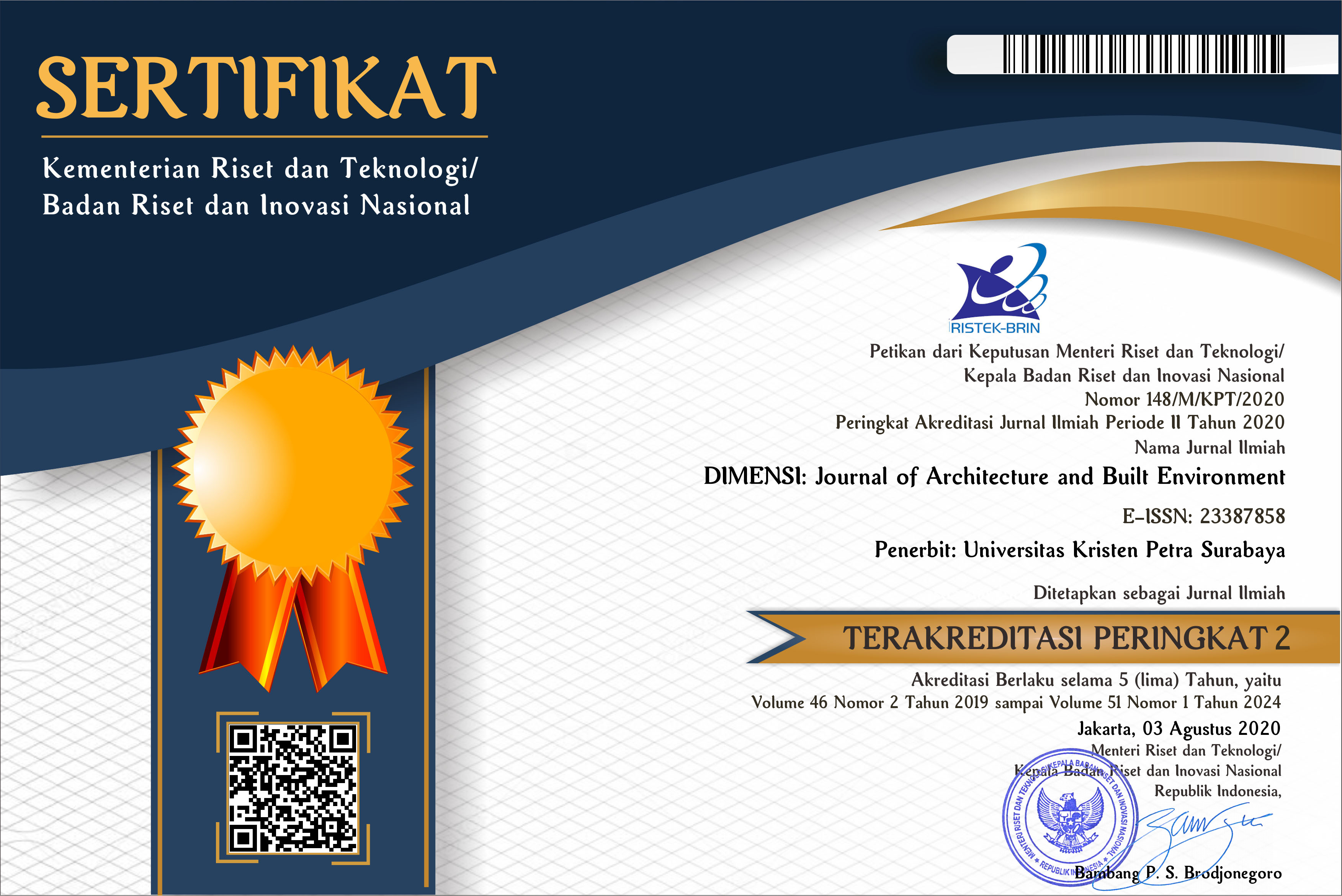MUTUALISM SYMBIOSIS BETWEEN PEDESTRIANS AND STREET VENDORS (Case Study: Pedestrian Ways in Dr Radjiman Street Surakarta)
 :
:
https://doi.org/10.9744/dimensi.44.1.61-66
Keywords:
Mutualism symbiosis, pedestrian, street vendorsAbstract
The spatial development of Surakarta is characterized as a transition city between residential and commercial activities. Within the area, the city center develops around the Kasunanan and the Mangkunegaran palaces; here in these two regions the study was conducted. The study conducted in Dr Radjiman Street Solo aims to analyze the characteristics and service facilities for pedestrians on this road segment. Generally speaking, this study is an analytical, descriptive study using qualitative rationalistic approach that focuses on the behavioral approach with behavioral mapping technique. Behavioral mapping approach is used because it is considered as the most suitable and supporting method to identify problems related to the relationship between human and its environment (its spatial system), as well as to make improvements on the design, especially in the commercial area of Dr Radjiman Street. According to this study, the perceptions of street vendors (PKL) are as follows: 1. Street vendors consider that the sidewalk is a space that they can use as a place for trading; 2. This is due to the trade location and their residential area is just as far as 1-2 km; 3. In addition, the merchants also consider that they (and their family) had used the location for more than >15 years, thus they unwilling to move away from that location. On the other hand, some factors which become visitor perceptions related to the existence of sidewalks in the Corridor of Dr. Radjiman Street are: 1. The visitors consider that the existence of street vendors make the pavement becomes such an uncomfort place (53.3%), this is because the space for pedestrians become narrowed for <3 meters.
Downloads
References
Akhma. (2008). Kamus Besar Indonesia-Inggris, Inggris-Indonesia, Gramedia Press, Jakarta.
Burton, E. & Mitchel, L. (2006). Inclusive Urban Design, Street for Life, Elsevier Ltd, United Kingdom.
Cliff, M. (2005). Urban Design Street and Square, Third Edition, Elsevier, United Kingdom.
Darmawan, E. (2005). Analisa Ruang Publik Arsitektur Kota, Badan Penerbit Universitas Diponegoro, Semarang.
Hakim, R. & Utomo, H. (2004). Komponen Perancangan Arsitektur Lansekap, Prinsip-Unsur dan Aplikasi Desain, Bumi Aksara, Jakarta.
Harjoko, T.Y & Adianto, J. (2011). Space Topology: Case Study of Kakilima in the Market of Kebayoran Lama, Jakarta. Journal Procedia - Social & Behavioral Sciences, 36, pp.545 – 556.
Haryadi & Setiawan, B. (2010). Arsitektur Lingkungan dan Perilaku: Pengantar ke Teori, Metodologi dan Aplikasi, Gadjah Mada University Press, Yogjakarta.
Haryono, P. (2011). Sosiologi Kota Untuk Arsitek, Bumi Aksara, Jakarta.
Kotler, P. (2000). Marketing Management, Analysis, Planning, Implementation and Control. Edisi IX. New Jersey; Prentice Hall.
Kuntjoro, J.D. (1986). Kemiskinan di Indonesia, Yayasan Obor, Jakarta.
Muhadjir, N. (2000). Metodologi Penelitian Kualitatif Edisi IV, Rake Sarasin, Yogyakarta.
Moleong, L.J. (2000). Metodologi Penelitian Kualitatif, PT. Remaja Rosdakarya, Bandung.
Sudjana, N. & Ibrahim. (1989). Penelitian dan Penilaian Pendidikan, Penerbit Sinar Baru, Bandung.
Yuli Puspitasari, A. (2006). Pengaruh Aktivitas PKL terhadap Linkage antara Kraton Kasunanan – Pasar Gede Kota Surakarta, Tesis, Program Pasca Sarjana, Magister Teknik Arsitektur, Universitas Diponegoro, Semarang.
Zahnd, M. (1999). Perancangan Kota Secara Terpadu, Kanisius, Yogyakarta.
Downloads
Published
How to Cite
Issue
Section
License
Authors who publish with this journal agree to the following terms:
- Authors retain copyright and grant the journal right of first publication with the work simultaneously licensed under a Creative Commons Attribution License that allows others to share the work with an acknowledgement of the work's authorship and initial publication in this journal.
- Authors are able to enter into separate, additional contractual arrangements for the non-exclusive distribution of the journal's published version of the work (e.g., post it to an institutional repository or publish it in a book), with an acknowledgement of its initial publication in this journal.
- Authors are permitted and encouraged to post their work online (e.g., in institutional repositories or on their website) prior to and during the submission process, as it can lead to productive exchanges, as well as earlier and greater citation of published work (See The Effect of Open Access).


















